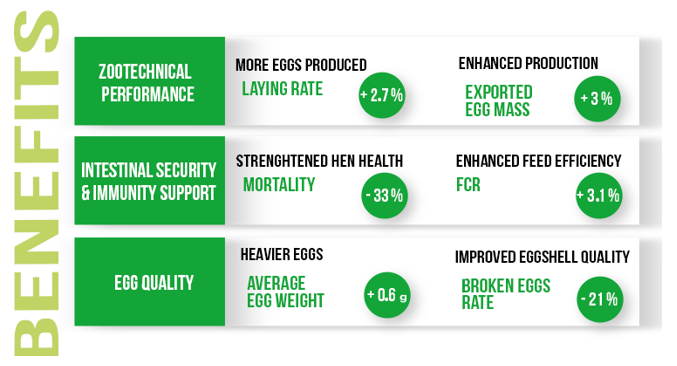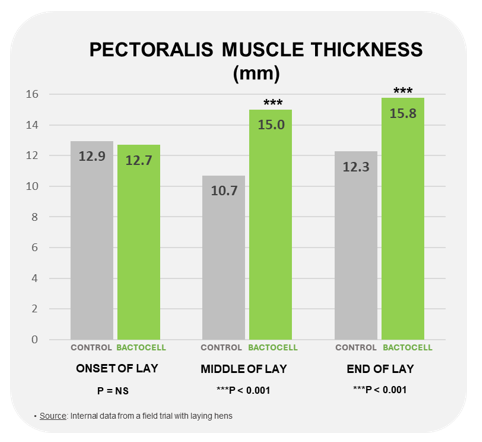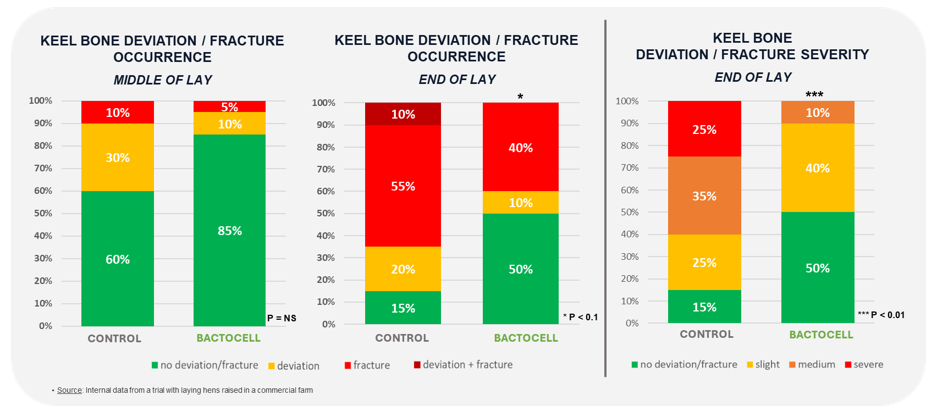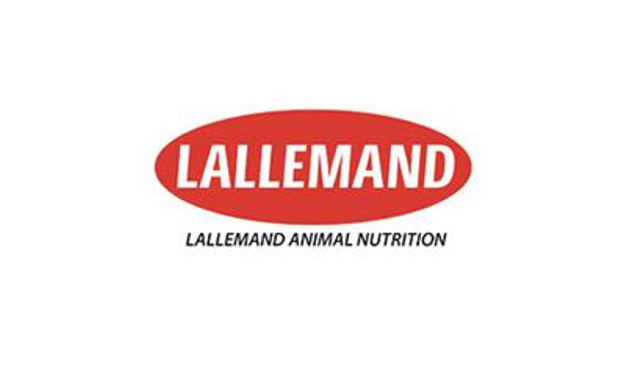



Evaluating pectoralis muscle and skeletal development using non-invasive methods
A new way to assess the benefits of Bactocell on laying performance and egg qualityAs highlighted in recent scientific studies, keel bone damages can result in significant welfare challenges for laying hens. Due to its anatomical position, keel bone is prone to deformities, especially in modern layers with smaller pectoralis muscle. Up to 90% of laying hens housed in aviary systems are affected by keel bone fractures, which are likely to cause pain and suffering. Nowadays, modern genetics are highly efficient. Hens producing up to 500 eggs per cycle (extended up to 100 weeks of age) have high calcium (Ca) requirements. This laying productivity can thus negatively impact keel bone health. It is worth noting that eggshell formation relies on Ca source from the skeleton, where 20 to 40% is stored after being supplied through feed. Keel bone damages comprises both fractures and deviations. Fractures often result from a collision with housing equipment, such as perches, resulting in a partial or large fracture with bone displacement. These fractures are strongly associated with pain and a drop in egg production. On the other hand, deviations tend to develop gradually as a result of constant pressure on the keel bone due to extended perching behaviour and/or osteoporosis. Ensuring good skeletal development and managing Ca metabolism during the laying period are crucial to sustain hen welfare and economic performance. Some correlation between lowered egg quality and susceptibility to keel bone fractures has been established. Furthermore, muscle development and protein retention are crucial in maintaining the persistency of the laying curve.

Pectoralis muscle development and keel bone integrity are therefore key predictors of laying performance and persistency. Lallemand has developed a new application of ultrasonography to investigate these parameters in a non-invasive way and objectively demonstrate the benefits of a probiotic, Pediococcus acidilactici CNCM I-4622 (BACTOCELL), on hen pectoralis muscle and bone development while supporting welfare.
Bactocell benefits on laying performance and egg quality
Over the past two decades, the use of this probiotic dedicated to monogastric animals has been extensively documented with more than 100 scientific publications. This lactic acid bacteria was specifically selected for its ability to exclusively produce high levels of L-lactic acid (a source of energy for birds).
Improved laying rate and persistency as well as greater eggshell quality were observed following supplementation with this probiotic. A meta-analysis was recently carried out to assess the impact of BACTOCELL supplemented at the commercial dose (1x109 CFU/kg of feed) on laying performance and egg quality. A total of 62 studies have been compiled, including both academic and field trials originating from 25 different countries, using different but relevant genetic lines. BACTOCELL supplementation significantly improved laying rate by 2.7% (P<0.001) and enhanced FCR by 3.1% (P<0.001). The average egg weight was 0.6 g higher for BACTOCELL-supplemented hens (P<0.001), leading to a significant increase of exported egg mass (CONTROL: 0.361 vs BACTOCELL: 0.372 kg/ hen/week, P<0.001). In addition, the incidence of broken or downgraded eggs was substantially reduced by 21% (P=0.015). Furthermore, the use of this lactic acid bacteria reduced mortality by 33% (CONTROL: 4.6 vs BACTOCELL: 3.1 %, P=0.005). Overall, this meta-analysis highlighted the benefits of using BACTOCELL to improve the performance of laying hens, regardless of housing system or production phase.

Bactocell benefits on pectoralis muscle development
Consistent results showing a significant increase of pectoralis muscle thickness were observed when supplementing different poultry species (pullets, layers, broilers) with this specific probiotic over different periods of time (Table 1).

As mentioned in Table 1 and detailed by Figure 2, a recent field trial performed in laying hens showed a significant improvement of pectoralis muscle thickness by both the middle and the end of the laying cycle when layers were supplemented with BACTOCELL (+40% and +28% vs control group, P<0.001).

Bactocell benefits on bone metabolism
Bone resistance and mineralization are essential to ensure optimal eggshell quality.
A trial performed on 50-week-old layers supplemented with BACTOCELL for 14 weeks showed an improvement of both Ca and phosphorus (P) retention (+4.2 % and +4.1%, respectively, P<0.05) and an increase of blood Ca and P concentration (+5% and +12%, respectively, P<0.05) compared to control hens. Moreover, higher bone Ca and P concentrations were observed in the BACTOCELL group (+4% and +7%, respectively, P <0.05). These results can be translated into enhanced bone hardness (+19%, P<0.1) and bone cohesiveness (+43%, P<0.05). Blood calcitriol, which is the active form of vitamin D (also known as 1,25-dihydroxycholecalciferol, 1,25(OH)2D3, a Ca absorption promoter), increased by 83% (P<0.05) with BACTOCELL supplementation. Blood osteocalcin concentration was also improved by 2.75% with the probiotic (CONTROL: 278.55 vs BACTOCELL: 286.20 ng/mL, P<0.1). Osteocalcin is a key hormone in bone metabolism. It is synthesized by osteoblasts and used as a biomarker of osteoblast activity and bone formation.
Furthermore, in a recent field trial (internal data, Italy, 2024), laying hens supplemented with BACTOCELL showed fewer keel bone deviations (10% vs 20% in control group) and keel bone fractures (40% vs 55% in control group). More intact keel bone were observed in the BACTOCELL group (50% vs 15% in control group). Some laying hens presented both keel bone deviation and fracture (10%), but all of them were in the control group. When some keel bone deviation and/or fracture were observed, their severity was reduced in the probiotic-supplemented group (Figure 3).

Using ultrasonography to evaluate breast muscle development and bone mineralization can prevent the routine use of invasive measurements involving the death of birds, especially in the current context of extending hen life cycles for economic, societal and environmental concerns. Ultrasonography can therefore be considered as a valuable diagnostic tool to predict laying performance and egg quality while supporting animal welfare. This method can be used to objectively demonstrate the benefits of the probiotic Pediococcus acidilactici CNCM I-4622 (BACTOCELL) on both muscle tissues and skeleton development, proving BACTOCELL to be a valuable nutritional strategy to safeguard laying performance and egg quality.
References available on request.
Not all products are available in all markets nor associated claims allowed in all regions.










